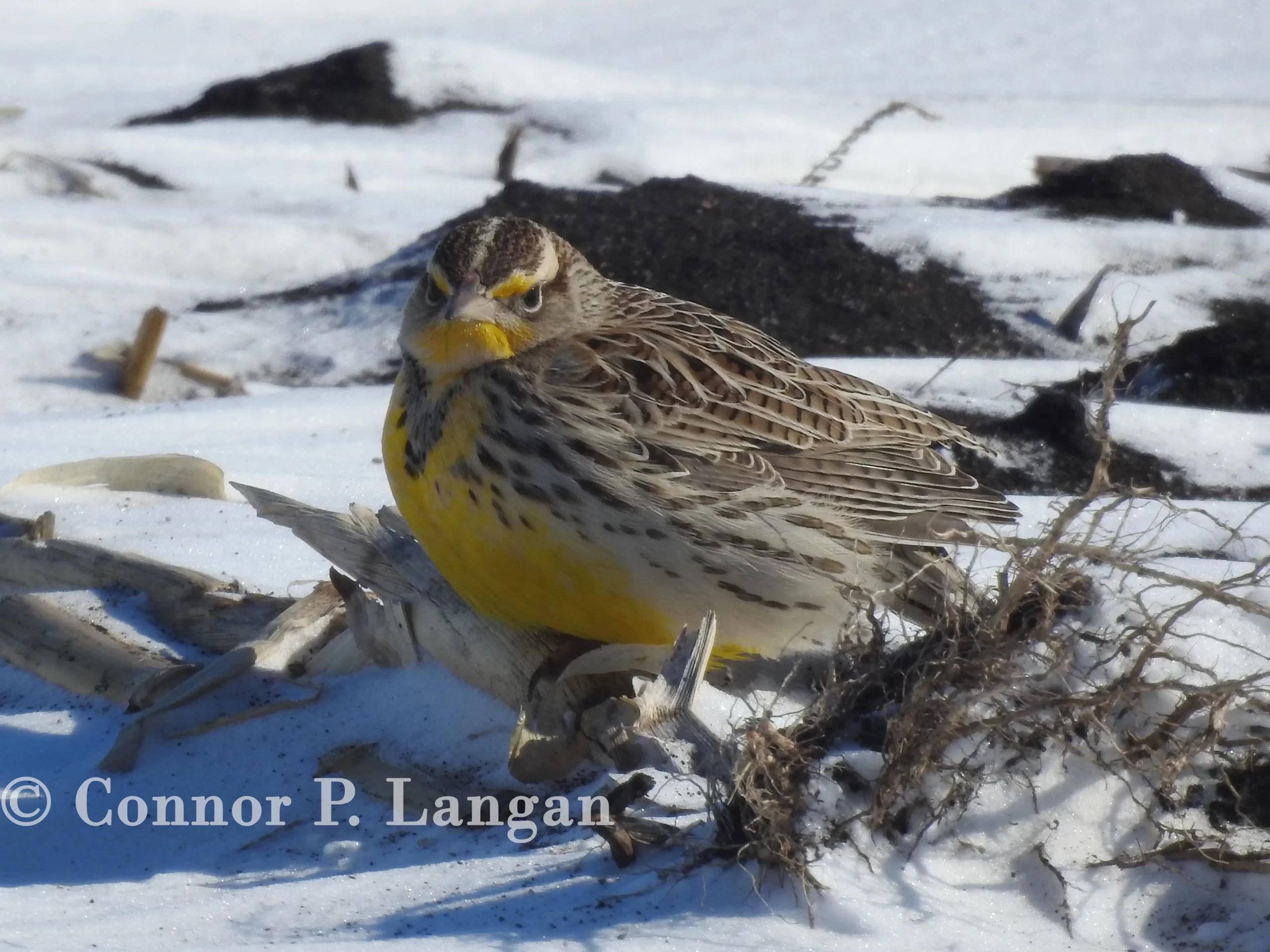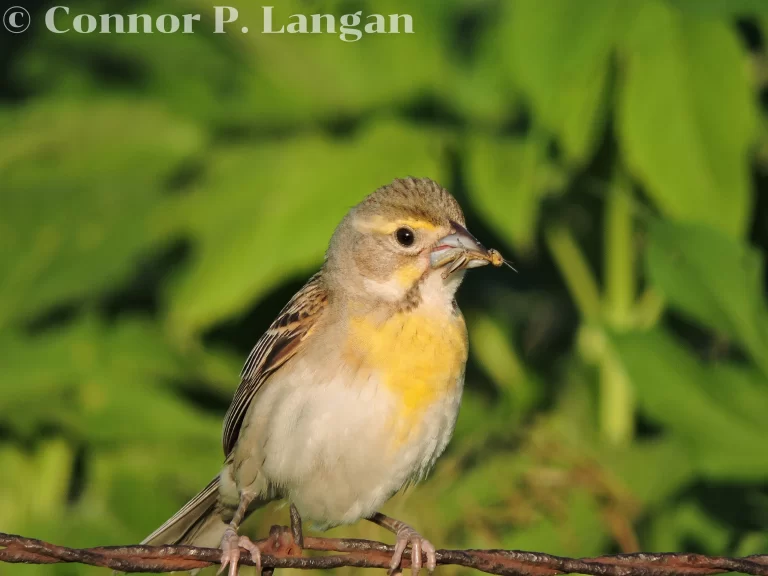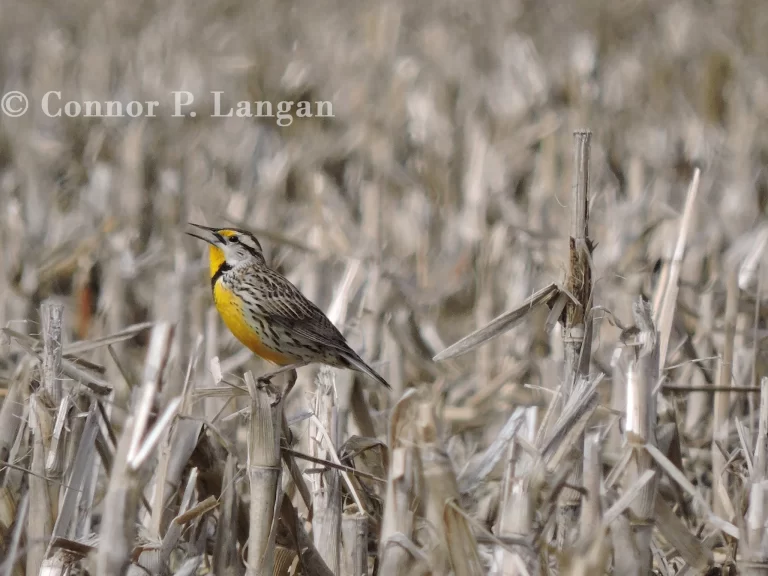Description
Western Meadowlarks are chunky blackbirds with large heads, short tails, and lengthy pointed beaks. This species is monomorphic.
These blackbirds can vary considerably in their length, measuring 7.5 to over 10 inches long. Western Meadowlarks may weigh just 3.2 ounces to just over 5 ounces.
Male and female Western Meadowlarks have brown crowns, yellow and white supercilia, dark lines extending behind their eyes, white cheeks, and yellow throats. This species has a dark necklace shaped like a V that covers much of its chest.
Western Meadowlarks have yellow stomachs, light brown flanks, and backs that are mottled with black, brown, and white colors.
Individuals are paler in the nonbreeding season, but they look largely the same during the breeding and nonbreeding seasons.
Western Meadowlarks are very similar to Eastern Meadowlarks. The best way to separate Western Meadowlarks from Eastern Meadowlarks is by distinguishing them by their songs. If you get a close look at a meadowlark, Western Meadowlarks have darker tails in flight and paler crowns than their Eastern counterparts.
Behavior
Male Western Meadowlarks are territorial during the breeding season, as they sing constantly and spar with other males to establish territories.
Female Eastern Meadowlarks are secretive all year, as they rarely leave the cover of dense grasses.
Western Meadowlarks tend to be more social than Eastern Meadowlarks, as this species is often observed in small groups during the nonbreeding season.
Diet
Western Meadowlarks are primarily insectivorous during the spring and summer. In the fall and winter, they may resort to eating seeds, fruits, and grains if insects are not available.
Habitat
Western Meadowlarks are grassland specialists, but they have learned to be fairly adaptable when sizable grasslands are absent. This species will breed and forage in prairies, rangelands, airports, fallow fields, and anywhere with considerable tracts of grass. Western Meadowlarks do not nest in grassy areas where shrubs are common on the landscape.
Range
This species has a sizable range, though it is not nearly as widespread as Eastern Meadowlarks. Western Meadowlarks are common west of the Great Plains, but this species can also be found throughout the upper Midwest in states like Iowa, Wisconsin, Minnesota, Illinois, and Michigan.
These birds are year-round residents throughout much of their range, though they migrate to southern Canada and the northern United States to breed in the summer. Western Meadowlarks can also be found in north-central Mexico.
Breeding
Western Meadowlarks are polygynous by nature, with the most dominant males attracting several females to their territory. Males that are not as experienced or dominant may struggle to establish a territory and attract females, so many males are left without mates.
Females take full responsibility for nest construction endeavors-a process that takes them as little as 6 and as many as 8 days. They seek out some sort of depression in a patch of dense grasses where they build cup-shaped nests out of grasses, leaves, and plant fibers. Females may build simple cup-shaped nests or complex nests that include several chambers.
Western Meadowlarks produce 1 to 2 broods of eggs every year, with each clutch typically containing 5 to 6 eggs. Eggs are incubated by the female for 13 to 16 days, and nestlings leave the nest a little over 10 days later.
Backyard Birding
Western Meadowlarks are not a species that will visit a bird feeder, nest in a birdhouse, or bathe in a birdbath. If a landowner wants to attract Western Meadowlarks to their property, they should have several acres of continuous prairie grass planted on or near their property.
Population Status
Western Meadowlarks have a total population that totals around 100 million birds. Despite their smaller range, their population is much larger than that of Eastern Meadowlarks.
This species has not experienced the serious declines that have decimated Eastern Meadowlark populations, but Western Meadowlarks have still lost around 37% of their total population in the last half-century.



